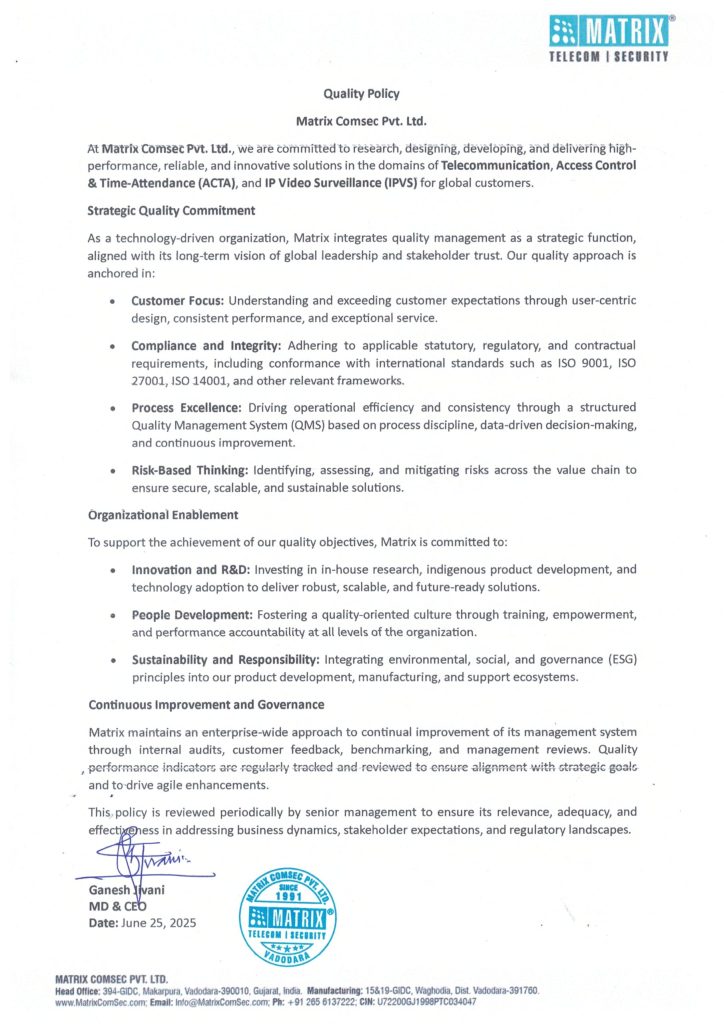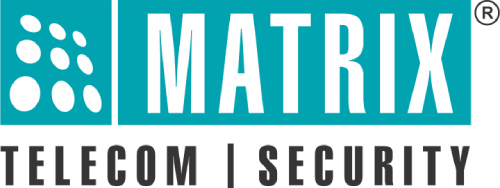“Safety of person overrides all the targets” is the health, safety, and environmental policy of Matrix Comsec Pvt. Ltd. Matrix believes that all injuries, occupational illnesses, safety incidents, and environmental incidents are preventable. Matrix shall strive to be a leader in the field of management of health, safety, and the environment.
Matrix is committed to
- Conduct all its activities in such a manner as to avoid harm to employees, contractors, and the community.
- promote the occupational health of its employees and contractors.
- continuously improve its environmental practices and performance.
- Minimize adverse impacts on the environment and risks to the community that arise due to its operations and during the transportation and distribution of its goods.
- Utilize energy resources in a responsible and efficient manner so as to reduce emissions and the generation of effluent and waste.
- Protection of the environment and prevention of pollution.
- Comply with all statutory and regulatory legal and other requirements concerning health, safety, and the environment.
- Create a culture of learning and practicing health, safety, and Environment.
- Environment systems, procedures, and practices among all its employees and contractors.
- Continuous Improvement in the Environment and Health and Safety Management System.
Matrix strives to achieve these objectives by
- Designing products with proper and adequate safeguards for ensuring process safety.
- Carrying out process and operational changes through well-defined systems and strict adherence to the same.
- Following effective use of safe working procedures and practices for operations, maintenance, inspection, and emergency situations.
- Reviewing regularly and updating systems and procedures.
- Training and validating employees and contractors on health and safety practices.
- Conducting all work in a safe manner and ensuring the integrity of the assets by providing personal protective equipment, tools, and tackles.
- Auditing periodically internal and external work procedures and practices.
- Investigating all incidents relating to health, safety, and environment, including minor ones and near misses, followed by the implementation of corrective measures.
- Communicating learning from investigations of internal and external incidents to all employees and taking steps to prevent such occurrences.
- Identifying and evaluating health risks related to operations and carrying out pre-employment and periodic health check-ups of its employees.
- Implementing programs and appropriate protective measures to control such risks.
E-Waste Management and Handling Rules
E-waste is a popular, informal name for electronic products nearing the end of their useful life. E-waste is considered dangerous, as certain components of some electronic products contain materials that are hazardous, depending on their condition and density. The hazardous content of these materials poses a threat to human health and the environment. Discarded computers, televisions, VCRs, stereos, copiers, fax machines, electric lamps, cell phones, audio equipment, and batteries, if improperly disposed of, can leach lead and other substances into soil and groundwater. Many of these products can be reused, refurbished, or recycled in an environmentally sound manner so that they are less harmful to the ecosystem.
Benefits of E-waste Recycling
Electronics recycling conserves natural resources.
There are many materials that can be recovered from old electronics. These materials can be used to make new products, thus reducing the need to mine for new raw materials. For instance, various metals can be recovered from computer circuit boards and other electronics, and the plastics and glass found in computer monitors and televisions can be recycled.
Electronics Recycling Supports the Community
Donating your old electronics plays an important role in the provision of refurbished products such as computers and mobile phones, which can be of great help to low-income families, schools, and not-for-profit organizations. It also helps individuals gain access to technology that they could not have otherwise afforded.
Electronics recycling creates employment locally.
Considering that around 90 percent of electronic equipment is recyclable, electronics recycling can play a significant role in creating employment. This is because new firms dealing with electronics recycling will form, and existing firms will look to employ more people to recover recyclable materials. This can be triggered by the increase in demand for electronics recycling.
Electronics recycling helps protect public health and the environment.
Many electronics have toxic or hazardous materials such as mercury and lead, which can be harmful to the environment if disposed of in trashcans. Reusing and recycling electronics safely helps keep hazardous materials from harming humans or the environment. For example, televisions and computer monitors are hazardous since they have lead in them. Printed circuit boards contain harmful materials such as cadmium, lead, mercury, and chromium. Also, batteries in computers and other electronics may contain hazardous materials such as cadmium, mercury, and lead.
Instead of keeping old electronics in the house or dumping them in landfills, recycling or reusing them is an appropriate option that should be supported by individuals and organizations. Considering the benefits of electronics recycling, it is very important that people in various parts of the world embrace this concept.
Creates Jobs: E-waste recycling creates new jobs for professional recyclers and creates a second market for the recycled materials.
The information security management system is integral to Matrix Comsec Pvt. Ltd.’s operations. We strive to assure the integrity of all the information we procure, produce, manage, or store, which is duly handled through robust confidentiality procedures. This policy aims to protect our information assets from any internal, external, deliberate, or accidental threats. To pursue the policy, we shall:
- Ensure that all information, including internal, third-party, personal, and electronic data, is treated with complete confidentiality.
- Maintain the integrity of all such information.
- Ensure that our information system meets the needs of our core and supporting business operations.
- Comply with all applicable statutory and regulatory requirements.
- Safeguard the security of our information assets through effective business continuity management.
- Make information available to staff and the public with minimum disruption.
- Increase staff awareness of information security management through education and training.
- Perform reliable access control to protect our information system against unauthorized access.
Applicability:
- All breaches of information security, actual or suspected, will be reported to and investigated by authorized persons, including the system.
- Administrator and information security manager.
- The Information Security Management Committee is responsible for documenting and maintaining the Information Security Management System.
- Information security documents, not limited to policies, procedures, and guidelines, will be made available in both hardcopy (limited numbers) and online format through an intranet system to support the ISMS policy.
- All managers shall implement the policy within their teams and ensure that every staff member adheres to the policy.
Maintaining high service standards is a key aspect and priority at Matrix Comsec Pvt. Ltd. Our policy with respect to all IT services is to:
- Continually improve the effectiveness of the service management system and the services.
- Enhance the current processes to bring them into line with good practices as defined within ISO/IEC 20000.
- Achieve ISO/IEC 20000 certification and maintain it on an ongoing basis.
- Increase the level of proactivity (and the customer’s perception of proactivity) with regard to the ongoing delivery of services.
- Achieve an enhanced understanding of and relationship with the businesses to which the services are delivered.
- Make the delivery of services more measurable in order to provide a sound basis for informed decisions.
- Review service level metrics on an annual basis to assess whether it is appropriate to change them based on collected historical data and customer feedback.
- Obtain ideas for improvements via regular service meetings with customers and document them in a service improvement plan.
- Review the service improvement plan at regular management meetings in order to prioritize and assess timescales and benefits.
Ideas for service improvements may be obtained from any source, including customers, suppliers, IT staff, risk assessments, and service reports. Once identified, they will be added to the service improvement plan and evaluated by the staff member responsible for continual service improvements.
As part of the evaluation of proposed service improvements, the following criteria will be used:
- Cost
- Business Benefits
- Risk
- Implementation Timescale
- Resource Requirements
Applicability: All customer- or supplier-facing departments


